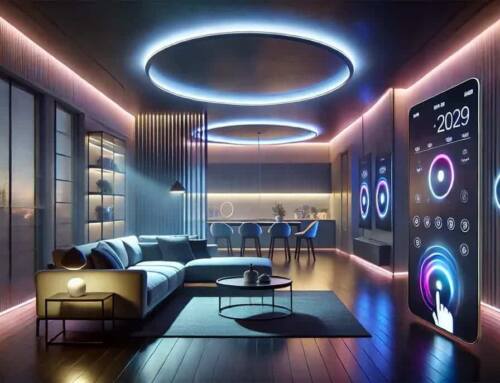LED strips and energy efficiency: Reducing home costs
In recent years, LED strips have become a popular choice for home lighting, not only for their versatility and aesthetics but also for their energy efficiency. One of the most common questions among users is: How much energy does an LED strip consume? This article will address this and other questions related to the energy efficiency of LED strips, providing valuable information for those looking to reduce home costs.
How much energy do LED lights consume?
To understand the efficiency of LED lights, it is crucial to know how much energy LED lights consume. Compared to traditional incandescent bulbs, LEDs use significantly less energy. For example, a high-quality LED strip may consume only 7 to 15 watts per meter, compared to the 60 to 100 watts of an equivalent incandescent bulb.
What is the efficiency of LED lights?
The energy efficiency of LED lights is one of their main advantages. How efficient are LED lights? The answer is simple: LED lights convert more than 90 % of the energy they consume into useful light, while incandescent bulbs only convert about 10 %, losing the rest as heat. This not only reduces energy consumption but also decreases the thermal load in the home, which can help lower cooling costs.
Which has higher energy consumption: an LED strip or a bulb?
When comparing the energy consumption of an LED strip and a bulb, LED strips are generally more efficient. A typical incandescent bulb consumes between 60 and 100 watts, while an LED strip can illuminate the same space with less than 20 watts. Additionally, LED strips offer greater flexibility in terms of installation and design, allowing for more uniform and customized lighting.
Do LED strips use a lot of power?
A common question is whether LED strips use a lot of power. The answer is no. Thanks to their advanced technology and design, LED strips emit light efficiently without wasting energy. This means you can illuminate large areas of your home with a fraction of the energy consumption of traditional bulbs.
What is the hourly power consumption of an LED strip?
Another important consideration is how much an LED strip consumes per hour. On average, an LED strip typically consumes between 7 and 15 watts per meter, per hour. This translates to extremely low operating costs, especially when compared to other lighting options.
Optimize your home with LED strips
Are you ready to start using LED strips in your home? At SIRS-E, we offer a wide range of high-quality LED products designed to maximize energy efficiency and reduce operational costs. Visit our catalog and find the perfect lighting solution for your needs: start saving today with SIRS-E.Title: LED strips and energy efficiency
Meta Description: In this post about LED strips and energy efficiency, we answer questions such as how efficient these lights are and how much energy they consume.
LED strips and energy efficiency: Reducing home costs
In recent years, LED strips have become a popular choice for home lighting, not only for their versatility and aesthetics but also for their energy efficiency. One of the most common questions among users is: How much energy does an LED strip consume? This article will address this and other questions related to the energy efficiency of LED strips, providing valuable information for those looking to reduce home costs.
How much energy do LED lights consume?
To understand the efficiency of LED lights, it is crucial to know how much energy LED lights consume. Compared to traditional incandescent bulbs, LEDs use significantly less energy. For example, a high-quality LED strip may consume only 7 to 15 watts per meter, compared to the 60 to 100 watts of an equivalent incandescent bulb.
What is the efficiency of LED lights?
The energy efficiency of LED lights is one of their main advantages. How efficient are LED lights? The answer is simple: LED lights convert more than 90 % of the energy they consume into useful light, while incandescent bulbs only convert about 10 %, losing the rest as heat. This not only reduces energy consumption but also decreases the thermal load in the home, which can help lower cooling costs.
Which has higher energy consumption: an LED strip or a bulb?
When comparing the energy consumption of an LED strip and a bulb, LED strips are generally more efficient. A typical incandescent bulb consumes between 60 and 100 watts, while an LED strip can illuminate the same space with less than 20 watts. Additionally, LED strips offer greater flexibility in terms of installation and design, allowing for more uniform and customized lighting.
Do LED strips use a lot of power?
A common question is whether LED strips use a lot of power. The answer is no. Thanks to their advanced technology and design, LED strips emit light efficiently without wasting energy. This means you can illuminate large areas of your home with a fraction of the energy consumption of traditional bulbs.
What is the hourly power consumption of an LED strip?
Another important consideration is how much an LED strip consumes per hour. On average, an LED strip typically consumes between 7 and 15 watts per meter, per hour. This translates to extremely low operating costs, especially when compared to other lighting options.
Optimize your home with LED strips
Are you ready to start using LED strips in your home? At SIRS-E, we offer a wide range of high-quality LED products designed to maximize energy efficiency and reduce operational costs. Visit our catalog and find the perfect lighting solution for your needs: start saving today with SIRS-E.












Leave A Comment
You must be logged in to post a comment.